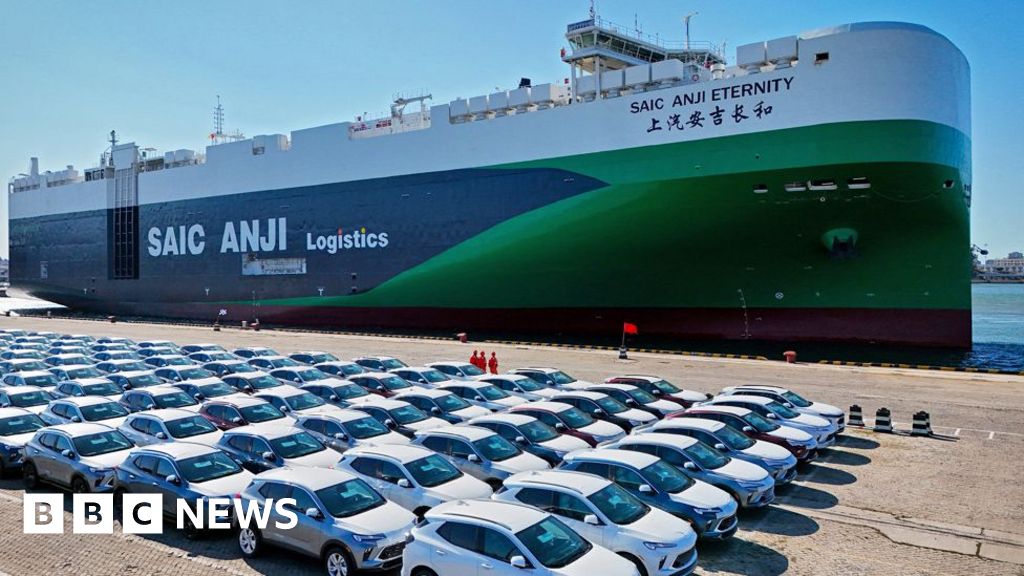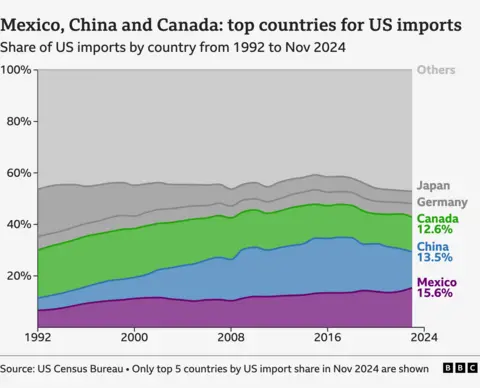

Getty Images
Former President Donald Trump has announced plans to impose a new 10% tariff on imports from China, marking the latest chapter in his ongoing trade disputes.
Currently, goods imported from China already incur a minimum tax of 10%, implemented through an earlier tariff directive from Trump.
China’s foreign affairs ministry has expressed its strong disapproval, stating its “firm opposition” to the proposed tariffs.
On the same day, Trump reiterated his intention to proceed with the previously threatened 25% tariffs on products from Canada and Mexico, scheduled to take effect on March 4.
These remarks coincide with negotiations taking place in Washington between officials from Mexico and Canada to avert the tariffs.
Trump previously announced the potential implementation of 25% tariffs targeting Mexico and Canada unless enhanced border security measures were agreed upon.
He momentarily suspended these tariffs after Mexico and Canada agreed to bolster funding for border security and engage in further discussions about drug trafficking prevention.
On social media, Trump expressed concerns that insufficient action had been taken to control the influx of fentanyl into the United States.
“Drugs continue to flood into our country from Mexico and Canada at alarming levels,” he stated, noting that a significant portion of these drugs are manufactured in China.
In response, Mexican President Claudia Sheinbaum commented at a press briefing, acknowledging Trump’s unique style of communication and expressing hope for a resolution by March 4.
Canadian Prime Minister Justin Trudeau also emphasized his country’s commitment to reaching an agreement, cautioning that any tariffs from the U.S. would trigger a swift and strong retaliation.
The prospect of Trump’s tariff threats has raised concerns, given the deep economic ties established between the North American nations under free trade agreements.
Leaders from both nations have previously indicated their willingness to implement counter-tariffs against the U.S. should these plans come to fruition.
Tariffs represent a government-imposed tax on imported goods, typically borne by the companies bringing these products into the nation.
In terms of trade, China, Mexico, and Canada rank as the top three partners for the United States, contributing over 40% of its imports last year.
Economic analysts have cautioned that tariffs on goods from these nations could result in price increases within the U.S. affecting a diverse range of items, from technology to food products.
Trump’s proposed additional 10% tax on Chinese imports, set to take effect on Tuesday, was previously undisclosed, although he had advocated for border taxes of up to 60% during his presidential campaign.
A representative from China’s foreign affairs ministry, Lin Jian, accused Trump of using the fentanyl crisis as a pretext for imposing tariffs, reiterating that China has one of the world’s strictest drug control regulations.
He asserted, “Pressure, coercion, and threats are ineffective approaches to engage with China.”
Liu Pengyu, another spokesperson for the Chinese Embassy, noted that China has been collaborating with the U.S. to address concerns related to fentanyl, highlighting progress in information sharing and cooperation.
He remarked that “reducing domestic drug demand and enhancing law enforcement cooperation are fundamental solutions,” while warning that Trump’s tariff initiatives could jeopardize future anti-drug cooperation.
“The unilateral tariffs imposed by the United States will not resolve its own issues, nor will they benefit either nation or the global community,” he concluded.

Trump’s statements, emphasizing the urgent need to restrict the flow of drugs, appear to be designed to encourage negotiations between the U.S., Mexico, and Canada, noted trade analyst Christine McDaniel from the Mercatus Center.
On Thursday, amid escalating tariff discussions, two allegedly prominent figures from the Zetas cartel, Miguel Angel Trevino Morales and his brother Oscar, were extradited to the U.S.
Mexican media reported that these individuals are part of a larger group of drug lords being sent from Mexico to the U.S., marking a significant advancement in U.S.-Mexico security collaborations.
McDaniel indicated that the specifics of Trump’s demands regarding China remain unclear, increasing the likelihood that these tariffs will be implemented.
While Trump’s initial tariffs on China have taken a backseat to his threats against Canada and Mexico, the possibility of additional tariffs raises concerns regarding business reactions.
She anticipates that the economic impact will be more pronounced in China, stating, “While it may not be costless for the U.S., it appears to inflict greater costs on China.”
If the proposed tariffs come to fruition, the Canadian and Mexican economies are expected to suffer significantly as they rely heavily on the U.S. as a primary export destination.
Even if the tariffs are never enforced, analysts warn that the mere threat of these levies may negatively influence investment dynamics, particularly in the U.S.
In response to the initial tariffs from the U.S., China has retaliated with its own tariffs on American goods, such as coal and agricultural machinery.
Trump has largely dismissed concerns over potential harm to the American economy.










